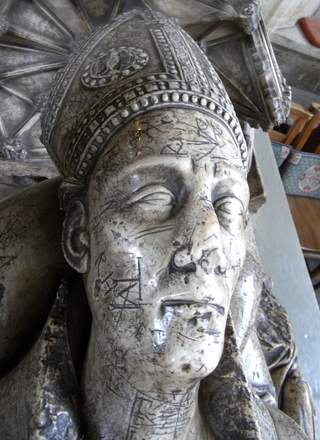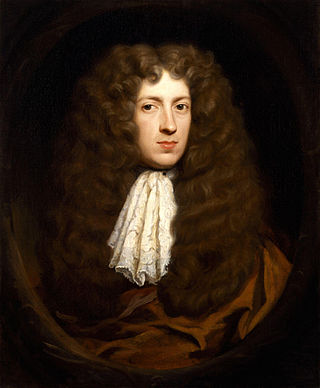Related Research Articles

Earl of Derby is a title in the Peerage of England. The title was first adopted by Robert de Ferrers, 1st Earl of Derby, under a creation of 1139. It continued with the Ferrers family until the 6th Earl forfeited his property toward the end of the reign of Henry III and died in 1279. Most of the Ferrers property and the Derby title were then held by the family of Henry III. The title merged in the Crown upon Henry IV's accession to the throne in 1399.

Thomas Howard, 2nd Duke of Norfolk, styled Earl of Surrey from 1483 to 1485 and again from 1489 to 1514, was an English nobleman, soldier and statesman who served four monarchs. He was the eldest son of John Howard, 1st Duke of Norfolk, by his first wife, Catharina de Moleyns. The Duke was the grandfather of both Queen Anne Boleyn and Queen Katherine Howard and the great-grandfather of Queen Elizabeth I. In 1513, he led the English to victory over the Scots at the decisive Battle of Flodden, for which he was richly rewarded by King Henry VIII, then away in France.

Marquess of Cholmondeley is a title in the Peerage of the United Kingdom. It was created in 1815 for George Cholmondeley, 4th Earl of Cholmondeley.

Diss is a market town and electoral ward in South Norfolk, England, near the boundary with Suffolk, with a population of 7,572 in 2011. Diss railway station is on the Great Eastern Main Line between London and Norwich. It lies in the valley of the River Waveney, round a mere covering 6 acres (2.4 ha) and up to 18 feet (5.5 m) deep, although there is another 51 feet (16 m) of mud.

Ranulf de Blondeville, 6th Earl of Chester and 1st Earl of Lincoln, known in some references as the 4th Earl of Chester, was one of the "old school" of Anglo-Norman barons whose loyalty to the Angevin dynasty was consistent but contingent on the receipt of lucrative favours. He has been described as "almost the last relic of the great feudal aristocracy of the Conquest".

Moulton is a civil parish and village in Cheshire, England, 3 miles (4.8 km) south of Northwich and 3 miles (4.8 km) north of Winsford.
Walter de Clifford (1113–1190) was an Anglo-Norman Marcher Lord of Bronllys Castle on the Welsh border, and was feudal baron of Clifford, seated at Clifford Castle in Herefordshire.

Edmund Stafford was Bishop of Exeter from 1395 to his death in 1419.
Vernon is a surname, from a masculine name that is derived from the Gallic word vern for Alder tree and a Gaulish-Latin suffix indicating a location. Thus Vernon is a "place of alders". Variants include Vern, Vernard, Verne, Verna, Sberna, Sberno. Vernon was introduced into England as an aristocratic surname at the time of the Norman conquest. It was adapted into Spanish as "Vernón".
Walter Fitz Robert of Woodham Walter, lord of Little Dunmow, Essex, was steward under Stephen of England, having succeeded to that position upon the death of his father, Robert Fitz Richard. Walter died in 1198 and was buried at Little Dunmow, in the choir of the priory of Austin canons.
Francis Vernon, 1st Earl of Shipbrook, known as The Lord Orwell between 1762 and 1776 and as The Viscount Orwell between 1776 and 1777, was an English politician.

James Vernon was an English Whig politician who sat in the English and British House of Commons between 1679 and 1710. He was Secretary of State for both the Northern and the Southern Departments during the reign of William III.
The Vernon family was a wealthy, prolific and widespread English family with 11th-century origins in Vernon, Normandy, France. Their extant titles include Baron Vernon and Vernon baronets of Shotwick Park.

Sir Richard Vernon was an English landowner, MP and speaker of the House of Commons.
William de Chesney was a medieval Anglo-Norman nobleman and sheriff. The son of a landholder in Norfolk, William inherited after the death of his two elder brothers. He was the founder of Sibton Abbey, as well as a benefactor of other monasteries in England. In 1157, Chesney acquired the honour of Blythburgh, and was sheriff of Norfolk and Suffolk during the 1150s and 1160s. On Chesney's death in 1174, he left three unmarried daughters as his heirs.
Robert fitzRoger was an Anglo-Norman nobleman and Sheriff of Norfolk and Suffolk and Northumberland. He was a son of Roger fitzRichard and Adelisa de Vere. FitzRoger owed some of his early offices to William Longchamp, but continued in royal service even after the fall of Longchamp. His marriage to an heiress brought him more lands, which were extensive enough for him to be ranked as a baron. FitzRoger founded Langley Abbey in Norfolk in 1195.
Rohese Giffard was a Norman noblewoman in the late 11th and early 12th century. The daughter of a Norman noble, she was the wife of another Norman noble, Richard fitzGilbert, who was one of the ten wealthiest landholders there after the Norman Conquest. Rohese is mentioned in Domesday Book as a landholder in her own right, something uncommon for women. She and Richard had a number of children, and she lived on past his death around 1086, until at least 1113 when she is recorded giving lands to a monastery. Her descendants eventually inherited her father's lands, although this did not occur until the reign of King Richard I of England.

Shipbrook Castle near Davenham in Cheshire was a Norman castle situated beside the River Dane, the exact site of which is now unknown. Davenham is recorded in the Domesday Book as Devenham. Its name means "hamlet on the River Dane". The site of the Norman Shipbrook Castle by the River Dane is indicated by the name of Castle Hill, between Shipbrook Bridge and Shipbrook Hill Farm, but no traces now remain. The site of the castle is thought to be on Castle Hill near Shipbrook Bridge. Castles such as Shipbrook were built during the Welsh Wars. It was demolished in about 1850.

The Domesday Book of 1086 AD lists King William the Conqueror's tenants-in-chief in Snotinghscire (Nottinghamshire), following the Norman Conquest of England:

The Domesday Book of 1086 AD identifies King William the Conqueror's tenants-in-chief in Cestrescire (Cheshire), following the Norman Conquest of England. At the time, the County of Cheshire included South Lancashire and most of modern Flintshire and Wrexham counties in north Wales.
References
- Colburn, Henry (1839). A Genealogical and Heraldic Dictionary of the Peerage and Baronetage of the British Empire.
 This article incorporates text from a publication now in the public domain : "Vernon, Richard de (DNB00)". Dictionary of National Biography . London: Smith, Elder & Co. 1885–1900.
This article incorporates text from a publication now in the public domain : "Vernon, Richard de (DNB00)". Dictionary of National Biography . London: Smith, Elder & Co. 1885–1900.